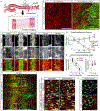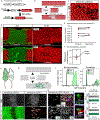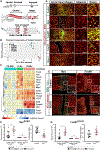Endothelial Regeneration of Large Vessels Is a Biphasic Process Driven by Local Cells with Distinct Proliferative Capacities
- PMID: 30075129
- PMCID: PMC6178982
- DOI: 10.1016/j.stem.2018.07.011
Endothelial Regeneration of Large Vessels Is a Biphasic Process Driven by Local Cells with Distinct Proliferative Capacities
Abstract
The cellular and mechanistic bases underlying endothelial regeneration of adult large vessels have proven challenging to study. Using a reproducible in vivo aortic endothelial injury model, we characterized cellular dynamics underlying the regenerative process through a combination of multi-color lineage tracing, parabiosis, and single-cell transcriptomics. We found that regeneration is a biphasic process driven by distinct populations arising from differentiated endothelial cells. The majority of cells immediately adjacent to the injury site re-enter the cell cycle during the initial damage response, with a second phase driven by a highly proliferative subpopulation. Endothelial regeneration requires activation of stress response genes including Atf3, and aged aortas compromised in their reparative capacity express less Atf3. Deletion of Atf3 reduced endothelial proliferation and compromised the regeneration. These findings provide important insights into cellular dynamics and mechanisms that drive responses to large vessel injury.
Keywords: angiogenesis; endothelial progenitor; single-cell sequencing; vascular; vascular repair.
Published by Elsevier Inc.
Conflict of interest statement
Disclosure of Conflicts of Interest:
The authors have no conflicts to disclose.
Figures







Comment in
-
Resident Endothelial Progenitors Make Themselves at Home.Cell Stem Cell. 2018 Aug 2;23(2):153-155. doi: 10.1016/j.stem.2018.07.014. Cell Stem Cell. 2018. PMID: 30075124
References
-
- Amati B, Alevizopoulos K, and Vlach J (1998). Myc and the cell cycle. Front Biosci 3, d250–68. - PubMed
-
- Asahara T, Murohara T, Sullivan A, Silver M, van der Zee R, Li T, Witzenbichler B, Schatteman G, and Isner JM (1997). Isolation of putative progenitor endothelial cells for angiogenesis. Science 275, 964–967. - PubMed
-
- Caplan BA, and Schwartz CJ (1973). Increased endothelial cell turnover in areas of in vivo Evans Blue uptake in the pig aorta. Atherosclerosis 17, 401–417. - PubMed
MeSH terms
Substances
Grants and funding
LinkOut - more resources
Full Text Sources
Other Literature Sources
Molecular Biology Databases
Miscellaneous

